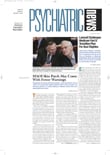Like the chicken and the egg, the question of whether depression precedes or follows risky adolescent drug use or sexual behavior has been a matter for discussion. A recent analysis based on a national sample of 13,491 youth in grades 7 to 11 concluded, however, that sexual and drug behavior predicts an increased likelihood of depression but not the reverse.
“Present findings do not support the theory that youth initiate sex and drug behaviors to `self-medicate' depression,” wrote Denise Hallfors, Ph.D., of the Pacific Institute for Research and Evaluation in Chapel Hill, N.C., and colleagues in the October American Journal of Preventive Medicine.
This may be especially the case for girls, they argued. “The greater exposure to stress due to risk behavior, and girls' more negative reactivity to interpersonal stressors, may partially account for demonstrated gender differences in depression.”
But other experts caution that the sample used in this study may not equate with patients who appear in a doctor's office.
“Self-medication may not be an issue in the general population of children, but it is a problem in the clinical population,” said Oscar Bukstein, M.D., M.P.H., an associate professor of psychiatry at the Western Psychiatric Institute and Clinic in Pittsburgh. “For about half of children seen in the clinic, quitting drugs does not end mood symptoms.”
Hallfors and colleagues drew on data from the National Longitudinal Study of Adolescent Health. They measured depression in two waves of the study using a modified version of the Center for Epidemiological Studies–Depression Scale (CES-D). The researchers compared responses to see whether an adolescent's presence in 16 risk clusters changed between Wave I (1995) and Wave II (1996). The clusters were defined by type and severity of drug, alcohol, or tobacco use and sexual behavior. Risk behaviors included cigarette use, alcohol consumption, binge drinking, marijuana or other illicit drug use, number of sexual partners, and having sex while under the influence of alcohol or drugs. Adolescents who had never engaged in any risk behavior were considered abstainers and constituted the reference group. Experimental behavior was defined as substance abuse once or not at all in the previous month and few, if any, sex partners. Youngsters in high-risk clusters had frequent use of any substance, very risky sexual behavior, or both.
“Compared to abstainers, membership in most risk behavior clusters at Wave I was significantly predictive of depression at Wave II,” they said. Depression among abstainers in Wave I did not predict experimental or high-risk behavior among boys at Wave II or experimental behavior in girls. Such existing depression did lower the likelihood of high-risk behavior among girls at Wave II.
Among girls in Wave I who had experimented with substances, depression increased the chance of entering a high-risk behavior cluster but didn't predict more experimental behavior.
Depression at the first wave did not result in additional experimentation at Wave II but did increase the chance of entering a high-risk behavior cluster then, the researchers said.
Gender differences were important, in their view.
“For females, even modest involvement in substance use and sexual experimentation elevates depression risk,” wrote Hallfors. “In contrast, boys show little added risk with experimental behavior, but binge drinking and frequent use of marijuana contribute substantial risk.”
Boys who use marijuana frequently or drink heavily should be screened for depression and counseled to stop or reduce use, they suggested. Equally, boys presenting with depression should be screened for substance abuse. Girls who use drugs or engage in sexual intercourse should be screened for depression, and depressed girls should be asked about such behaviors.
At present, U.S. Preventive Services Task Force (USPSTF) recommendations do not call for screening asymptomatic youth for depression. The USPSTF, sponsored by the federal Agency for Healthcare Research and Quality, is an independent panel of experts in primary care and prevention that systematically reviews the evidence of effectiveness of prevention programs and develops recommendations for clinical preventive services. By contrast, the current study suggests that screening may be useful in the case of adolescents with these specific behavior patterns, the researchers said.
Bukstein agreed that these higher-risk youth should be screened for depression, but cautioned that the order in which the depression and behaviors develop does not predict remission of depression once the young people halt these behaviors.
“You can't just say that substance abuse causes depression and assume that getting them abstinent will end the depression,” he told Psychiatric News. “You can't wait six months to find out.”
The emerging standard calls for treating depression concurrently with drug, alcohol, or tobacco treatment and counseling for other risky behavior, said Bukstein.
“Which Comes First in Adolescence—Sex and Drugs or Depression?” is posted at<www.ajpm-online.net/article/PIIS0749379705002138/fulltext>.▪
